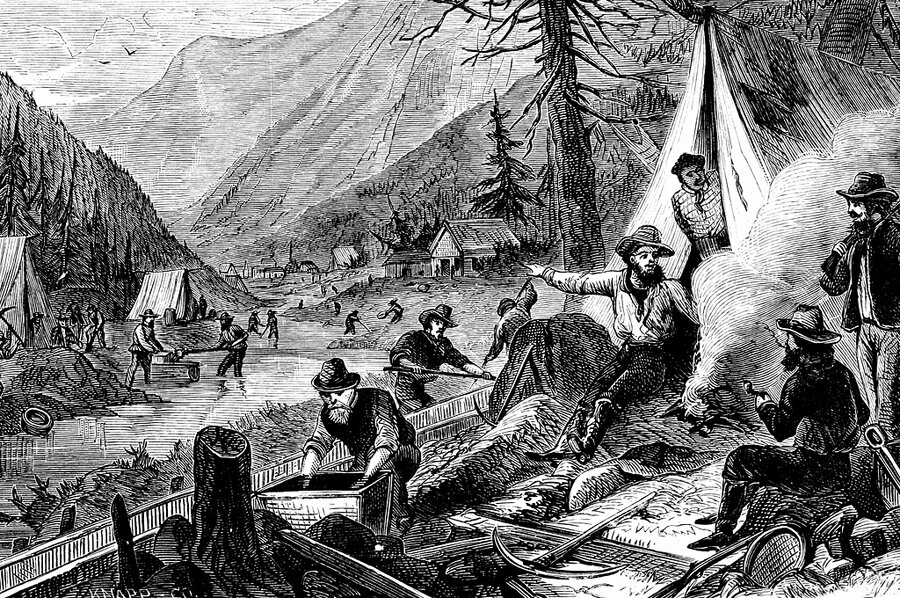From gold rush to gold standard: history's filigree
Loading...
•5500-2500 BC Gold is first discovered in the later part of the Stone Age, probably in Mesopotamia.
•3000 BC Gold rings are used for payments in Egypt.
•650 BC The Lydian Lion – a bean-shaped gold piece stamped with a lion – is considered the first true coin. It is first minted by Lydia, the ancient Greek kingdom ruled by Croesus a century later.
•250 BC The Greek mathematician Archimedes demonstrated that the purity of gold can be determined by calculating its density (weight and amount of water it displaces•).•
•AD 1284 Venice introduces the gold ducat, which becomes the most popular coin in world commerce for more than five centuries.
•1511 King Ferdinand of Spain sets the tone for his expeditions to the New World, admonishing his explorers: "Get gold, humanely if you can, but at all hazards, get gold."
•1787 First American gold coin – the Brasher doubloon – is struck by gold- and silversmith Ephraim Brasher.
•1792 The Coinage Act puts the US on a bimetallic silver-gold standard, defining the dollar as equivalent to 24.75 grains of fine gold and 371.25 grains of fine silver.
•1799 The first US gold rush is sparked by the discovery of a 17-pound gold nugget at Little Meadow Creek, N.C.
•1821 Britain institutes the first gold standard.
•1848 The discovery of gold at Sutter's sawmill near Sacramento, Calif., sparked the California gold rush and accelerated settlement of the American West.
•1851 Australian gold rush begins in New South Wales, in the southeast.
•1870s North American gold finds make the metal more plentiful, prompting the US, Germany, and France to adopt the gold standard, followed by many other countries.
•1886 While digging up stones to build a house, George Harrison makes the largest gold discovery in history in Witwatersrand, South Africa. The deposit produces 40 percent of the world's gold by 1985.
•1887 Scottish chemist John Steward MacArthur wins a British patent for the gold cyanidation process. It enables the separation of gold from ore and doubles the world gold output within 20 years.
•1897 The Klondike gold rush sees 100,000 "stampeders" head north after gold is discovered in the Canadian Yukon the previous year.
•1900 The Gold Standard Act places the US officially on the gold standard, a fixed exchange rate in relation to other countries on the gold standard.
•1903 The Engelhard Corporation creates a liquid medium to print gold on surfaces – for tender and decoration. The medium becomes the basis for microcircuit printing technology.
•1913 Federal Reserve Act sets up a central banking authority and specifies that Federal Reserve notes be backed 40 percent in gold.
•1914-19 The strict gold standard is suspended by several countries, including the US and Britain, during World War I. Gold could be bought or sold in unlimited quantities.
•1933 On March 6, President Roosevelt declares a four-day national bank holiday to prevent the exporting or hoarding of gold or silver. On April 5, Roosevelt issues an order making it a felony for private citizens to own gold. (Collectors of gold coins dated 1933 or earlier are eventually exempted from the rule.) In June, the US abandons the gold standard.
•1937 The bullion depository at Fort Knox, Ky., opens.
•1942 The US War Production Board orders nonessential gold mines to cease operations.
•1944 The Bretton Woods Agreement outlining the global monetary system establishes a gold exchange standard with a fixed value of $35 an ounce.
•1961 Americans are forbidden to own gold abroad as well as at home. The central banks of Belgium, France, Italy, the Netherlands, Switzerland, West Germany, Britain, and the US form the London Gold Pool and agree to buy and sell at $35.0875 per ounce.
•1967 South Africa produces the first Krugerrand. The one-ounce bullion coin becomes a favorite investment globally.
•1968 A sudden surge in gold demand closes the London Gold Market for two weeks. Member nations of the gold pool decide to stop buying and selling gold in the private market and establish a two-tier pricing system: Official transactions between monetary authorities are to be conducted at a price of $35 per ounce and other transactions are to be conducted at a fluctuating free-market price.
•1971 President Nixon takes the dollar off the gold standard.
•1974 Gold backing of US Federal Reserve notes ends. President Gerald Ford lifts the ban on ownership of gold by US citizens. A congressional panel physically inspects Fort Knox to verify gold holdings in response to conspiracy theories that it held no gold at all.
•1975 Trading in gold for future delivery begins on New York's Commodity Exchange and on Chicago's International Monetary Market and Board of Trade.
•1979 The Canadian Maple Leaf, a one-ounce bullion coin, is introduced.
•1980 Gold reaches a historic single-day high of $870 per ounce on Jan. 21, but by year-end closes at $591.
•1999 The euro is introduced; the Pan-European currency is backed by a new European Central Bank holding 15 percent of its reserves in gold.
•2011 Gold price hits $1,512 per ounce.
Sources: Britannica.com; 'The Power of Gold: The History of an Obsession,' by Peter L. Bernstein; North Carolina Museum of History; University of Washington Libraries Klondike Gold Rush exhibit; US Treasury Dept.; National Mining Association; U.S. Geological Survey







